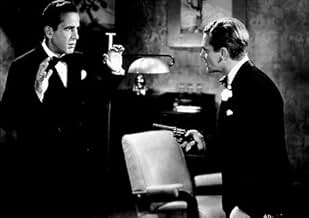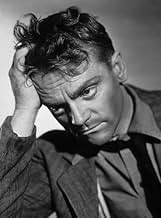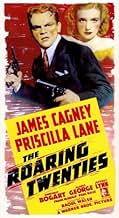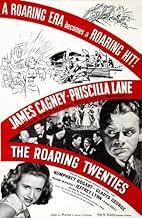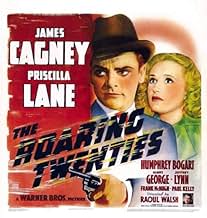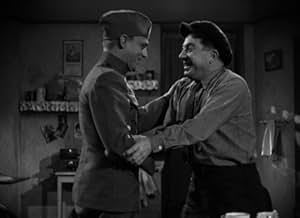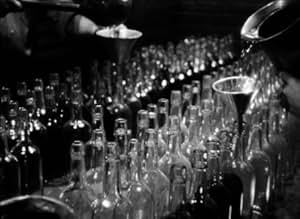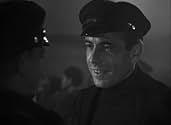IMDb रेटिंग
7.9/10
17 हज़ार
आपकी रेटिंग
अपनी भाषा में प्लॉट जोड़ेंThree men attempt to make a living in Prohibitionist America after returning home from fighting together in World War I.Three men attempt to make a living in Prohibitionist America after returning home from fighting together in World War I.Three men attempt to make a living in Prohibitionist America after returning home from fighting together in World War I.
- पुरस्कार
- कुल 4 जीत
Elisabeth Risdon
- Mrs. Sherman
- (as Elizabeth Risdon)
Edward Keane
- Henderson
- (as Ed Keane)
Eddy Chandler
- Second Detective
- (as Eddie Chandler)
John Deering
- Narrator
- (वॉइस)
फ़ीचर्ड समीक्षाएं
A spell of time spent on the front in World War One, leads to a life of opportunity and fun, as a decade makes an entrance, rules of the game become song and dance, with some liquor, a bit of conflict and some guns. Prohibition creates possibilities, to entertain the crowds in so called speakeasies, brewing spirits then creates, the drinks the Volsted Act just hates, though drinking too much might make you, a bit queasy. Alas new Presidents curtail the operations, meaning that changes come to all organisations, markets sink, then fall, decline, your social status realigns, in the end, was it all worth it, you will opine.
Sometimes I come to a film because it looks like it can directly fulfill, sometimes because it can provide precious background to other things that matter, letting them stand.
It's watchable in itself, this one; a misfit's rise and fall played against the passing of times. Released on the cusp of WWII, it opened a portal back to more careless times, taking us on a journey from WWI trenches through the highs of Prohibition to the lows of Depression, so we could have this clear moral stance: in the new world there's no room for scoundrels. Right.
Interesting here is that only a year or two before Citizen Kane we have a similar saga about the passing of the times, but one that asks no fundamental question of us, casts no doubt on its testimony. It's as lurid and constructed as newspaper headlines of the time, a main contrast in Welles' film about its world-creating newspaperman. It's machinegun history written in the staccato sounds of a newspaperman's typewriter.
What I really wanted to see though was Cagney.
I am in the middle of a film noir quest looking for its machinery, and as an aside I was brought to explore its roots in 1930's crime stuff. Cagney is a force in this niche. He had so much energy that he could turn into presence. He is not just amused, he doesn't coast on pushing things back like Bogart; he throws himself on the encounter, bitterly cutting himself on the edges.
Not so here. He was asked to play a basically decent guy led astray by the prospect of easy money, meaning to reflect the broader American endeavor that ended on Black Tuesday. Usually in a Cagney film he lets loose in the end. They asked of him here the precise opposite; he sleepwalks, numbed by failure, a human ruin clawing at redemption. He looks like he gives it his all, but it's just not who he is. It's as if you asked Welles to strut like Wayne.
If you want to see Cagney in top form, look him up in Footlight Parade fully in command of a show, White Heat to see him face real demons.
It's watchable in itself, this one; a misfit's rise and fall played against the passing of times. Released on the cusp of WWII, it opened a portal back to more careless times, taking us on a journey from WWI trenches through the highs of Prohibition to the lows of Depression, so we could have this clear moral stance: in the new world there's no room for scoundrels. Right.
Interesting here is that only a year or two before Citizen Kane we have a similar saga about the passing of the times, but one that asks no fundamental question of us, casts no doubt on its testimony. It's as lurid and constructed as newspaper headlines of the time, a main contrast in Welles' film about its world-creating newspaperman. It's machinegun history written in the staccato sounds of a newspaperman's typewriter.
What I really wanted to see though was Cagney.
I am in the middle of a film noir quest looking for its machinery, and as an aside I was brought to explore its roots in 1930's crime stuff. Cagney is a force in this niche. He had so much energy that he could turn into presence. He is not just amused, he doesn't coast on pushing things back like Bogart; he throws himself on the encounter, bitterly cutting himself on the edges.
Not so here. He was asked to play a basically decent guy led astray by the prospect of easy money, meaning to reflect the broader American endeavor that ended on Black Tuesday. Usually in a Cagney film he lets loose in the end. They asked of him here the precise opposite; he sleepwalks, numbed by failure, a human ruin clawing at redemption. He looks like he gives it his all, but it's just not who he is. It's as if you asked Welles to strut like Wayne.
If you want to see Cagney in top form, look him up in Footlight Parade fully in command of a show, White Heat to see him face real demons.
I got a kick out of this flick having seen in on TCM. In fact I get a kick out of all TCM movies because there are no commercials so whether you like or dislike Ted Turner, I gotta thank the man for giving us that channel and that format. It's just like sitting in the Bijou after buying a ticket for a quarter and a box of popcorn for a dime. Those were the days. When we hear the names Cagney and Bogart,what's taken for granted? Both were legends. Hollywood immortals whom as long as film is preserved, will never really be dead and "The Roaring Twenties" showcased the dynamic duo to the Nth degree. Bogie did not get top billing as did Jimmy however shining throughout that entire movie was unmistakable greatness yet to come from the guy with the impressive speech impediment. His villainous,conniving rotten gangster disposition was there to exploit in how many more films with him? And Cagney too was contemptible but in a nicer way-if indeed that makes any sense whatsoever. I guess I mean to write that if Cagney would shoot someone, he'd first apologize and then perhaps pay for the funeral.But when Bogie shot, his followup would be two or three more right to the gut. Regarding the story line of the film, it's quite straightfoward. Bogie and Cagney meet as Doughboys in France in W.W.I. The war ends, a few years later the Volstead Act becomes law which gives birth to bootlegging, rival murder etc. Jimmy, who's nuts about a gal who sings and is just out of high school is warned by his pal in booze,Bogie,that the gal is two-timing him for their lawyer and so forth and so on. A one time rock solid friendship between Cagney and Bogart disintegrate and why go on? See the film. It's classic gangster stuff and highly enjoyable.
Two of the most famous actors of their day - James Cagney and Humphrey Bogart - are featured here, along with two very interesting women (Priscilla Lane and Gladys George). That foursome would be fun to join anywhere.
Lane is the wholesome pretty girl and George is the tough female bar owner. The latter may not look as good but she delivers the best film noir lines in the movie near the end.
In addition, Jefferey Lynn is good as the clean-cut, nice-guy attorney and Frank McHugh draws laughs as Cagney's buddy (as in real life). Paul Kelly is convincing as a hood.
With this cast, you know you are going to get a well-acted movie. It moves at a good pace, too, with few lulls. The gangster language of the period was fun to hear.
The first time I saw this film I was disappointed. Maybe I expected too much. On the second viewing, I throughly enjoyed it. Having a great DVD transfer on the second viewing didn't hurt, either. It's a nice sharp picture.
Lane is the wholesome pretty girl and George is the tough female bar owner. The latter may not look as good but she delivers the best film noir lines in the movie near the end.
In addition, Jefferey Lynn is good as the clean-cut, nice-guy attorney and Frank McHugh draws laughs as Cagney's buddy (as in real life). Paul Kelly is convincing as a hood.
With this cast, you know you are going to get a well-acted movie. It moves at a good pace, too, with few lulls. The gangster language of the period was fun to hear.
The first time I saw this film I was disappointed. Maybe I expected too much. On the second viewing, I throughly enjoyed it. Having a great DVD transfer on the second viewing didn't hurt, either. It's a nice sharp picture.
It is not as centrally dynamic as THE PUBLIC ENEMY nor as Freudian as WHITE HEAT, but THE ROARING TWENTIES is a leading gangster film for Jimmy Cagney as it details the rise and fall of a gangster Eddie Bartlett. The product of World War I and Prohibition, Eddie rises to great power as the head of a gang, always trying to return to legitimate society, and then to fall again due to the Wall Street Crash and the machinations of his right-hand man George Hally (Humphrey Bogart).
Both men's characters are far more subtle as studies of success in criminal enterprise than the normal crime bosses of the 1930s. Eddie painstakingly builds up a taxicab corporation to gain legitimacy, as well as his stock acquisitions. Bogart, a bit more realistic on what types of businesses he understands, does not get involved in the stock market. But he enjoys the trappings of the upper class. Witness the scene when he is talking with his underling (Abner Biberman) and he is practicing his putting in his office. At the conclusion, Bogart is living in a townhouse (a sign of his financial success).
There is a tradition in the films of the depression that some gangsters are not as bad as others. This is not to be taken seriously in real life, but the idea is that certain people are driven to crime by economic circumstances (Cagney returning to no job at the end of World War I) and some are driven by pure evil (the sadistic side of Bogart's nature). Cagney, on his rise, gains the friendship of people like Gladys George (actually the unrequited love of Ms George) and tries to find room in his organization for people like Frank McHugh, a nice guy who really never fit in properly as a criminal - and dies as a result. Bogart gains the support of like villains (Bibberman, who shares Bogie's fate at the end), and keeps showing a contempt for human life in most of the film (witness how he kills a cop on one of the rum runners he and Cagney are on, because the cop was once his sergeant in the army who punished him for breaking the rules when he did). But Cagney turns out to have more guts in him than Bogie. At the end of the film the latter, facing his own demise, turns into a total coward.
The film has many touches to set the tone of the 21 years it covers (1918 - 1939). At the start newsreel footage takes the audience back to the end of World War I, showing Presidents and events up to Wilson (who, curiously enough, is shown by an actor playing the President, not as part of an old film). It has been noted that Gladys George's Panama is based on Texas Guinan, the speakeasy hostess. The death of Cagney on the steps of a church is based on the death of Hymie Weiss, a Chicago gangster rival of Capone who was killed that way in 1927. It was too good a death to not use in a gangster film, as it seems more symbolic than it was in real life (it does remind us of how Cagney, for all his good intentions, came up short due to his profession in violence).
I have not commented on the love triangles involving Cagney, Jeffrey Lynn, and Priscilla Lane (and Cagney, Lane, and Gladys George). The irony that Cagney never sees that George is more than just a good friend is rather poignant, for both of them. And it is George who cradles his dead body in the end and gives his epitaph. Perhaps today a director would allow Cagney to wise up and get away with George. But that would spoil the full effect of the film's conclusion.
Both men's characters are far more subtle as studies of success in criminal enterprise than the normal crime bosses of the 1930s. Eddie painstakingly builds up a taxicab corporation to gain legitimacy, as well as his stock acquisitions. Bogart, a bit more realistic on what types of businesses he understands, does not get involved in the stock market. But he enjoys the trappings of the upper class. Witness the scene when he is talking with his underling (Abner Biberman) and he is practicing his putting in his office. At the conclusion, Bogart is living in a townhouse (a sign of his financial success).
There is a tradition in the films of the depression that some gangsters are not as bad as others. This is not to be taken seriously in real life, but the idea is that certain people are driven to crime by economic circumstances (Cagney returning to no job at the end of World War I) and some are driven by pure evil (the sadistic side of Bogart's nature). Cagney, on his rise, gains the friendship of people like Gladys George (actually the unrequited love of Ms George) and tries to find room in his organization for people like Frank McHugh, a nice guy who really never fit in properly as a criminal - and dies as a result. Bogart gains the support of like villains (Bibberman, who shares Bogie's fate at the end), and keeps showing a contempt for human life in most of the film (witness how he kills a cop on one of the rum runners he and Cagney are on, because the cop was once his sergeant in the army who punished him for breaking the rules when he did). But Cagney turns out to have more guts in him than Bogie. At the end of the film the latter, facing his own demise, turns into a total coward.
The film has many touches to set the tone of the 21 years it covers (1918 - 1939). At the start newsreel footage takes the audience back to the end of World War I, showing Presidents and events up to Wilson (who, curiously enough, is shown by an actor playing the President, not as part of an old film). It has been noted that Gladys George's Panama is based on Texas Guinan, the speakeasy hostess. The death of Cagney on the steps of a church is based on the death of Hymie Weiss, a Chicago gangster rival of Capone who was killed that way in 1927. It was too good a death to not use in a gangster film, as it seems more symbolic than it was in real life (it does remind us of how Cagney, for all his good intentions, came up short due to his profession in violence).
I have not commented on the love triangles involving Cagney, Jeffrey Lynn, and Priscilla Lane (and Cagney, Lane, and Gladys George). The irony that Cagney never sees that George is more than just a good friend is rather poignant, for both of them. And it is George who cradles his dead body in the end and gives his epitaph. Perhaps today a director would allow Cagney to wise up and get away with George. But that would spoil the full effect of the film's conclusion.
क्या आपको पता है
- ट्रिवियाThis marked the end of James Cagney's cycle of gangster films for Warner Bros. Cagney wanted to diversify his roles: he would not play a gangster again until White Heat (1949), ten years later.
- गूफ़When Eddie and his men impersonate the Coast Guard, there's a miniature shot of the two boats pulling alongside each other. Nick's rum runner boat that George captains is a much taller boat and its deck is higher above the water than the smaller vessel. Yet when the shot changes to live action and Eddie's crew is throwing mooring lines across to the bigger boat, the decks are now the same height; furthermore, when the men cross from one boat to the other, they merely step over the rail instead of needing to climb up to the taller boat's deck.
- भाव
[last lines]
Panama Smith: He's dead.
Cop: Well, who is this guy?
Panama Smith: This is Eddie Bartlett.
Cop: Well, how're you hooked up with him?
Panama Smith: I could never figure it out.
Cop: What was his business?
Panama Smith: He used to be a big shot.
- कनेक्शनEdited from The Public Enemy (1931)
- साउंडट्रैकI'm Just Wild About Harry
(1921) (uncredited)
Music by Eubie Blake
Lyrics by Noble Sissle
Played during the opening and closing credits
Also played during the 1922 montage
Sung by Priscilla Lane at the club
टॉप पसंद
रेटिंग देने के लिए साइन-इन करें और वैयक्तिकृत सुझावों के लिए वॉचलिस्ट करें
- How long is The Roaring Twenties?Alexa द्वारा संचालित
विवरण
- रिलीज़ की तारीख़
- कंट्री ऑफ़ ओरिजिन
- भाषा
- इस रूप में भी जाना जाता है
- Roaring Twenties
- फ़िल्माने की जगहें
- उत्पादन कंपनी
- IMDbPro पर और कंपनी क्रेडिट देखें
- चलने की अवधि1 घंटा 46 मिनट
- रंग
- ध्वनि मिश्रण
- पक्ष अनुपात
- 1.37 : 1
इस पेज में योगदान दें
किसी बदलाव का सुझाव दें या अनुपलब्ध कॉन्टेंट जोड़ें



